brake PONTIAC BONNEVILLE 1997 Owners Manual
[x] Cancel search | Manufacturer: PONTIAC, Model Year: 1997, Model line: BONNEVILLE, Model: PONTIAC BONNEVILLE 1997Pages: 405, PDF Size: 18.83 MB
Page 6 of 405
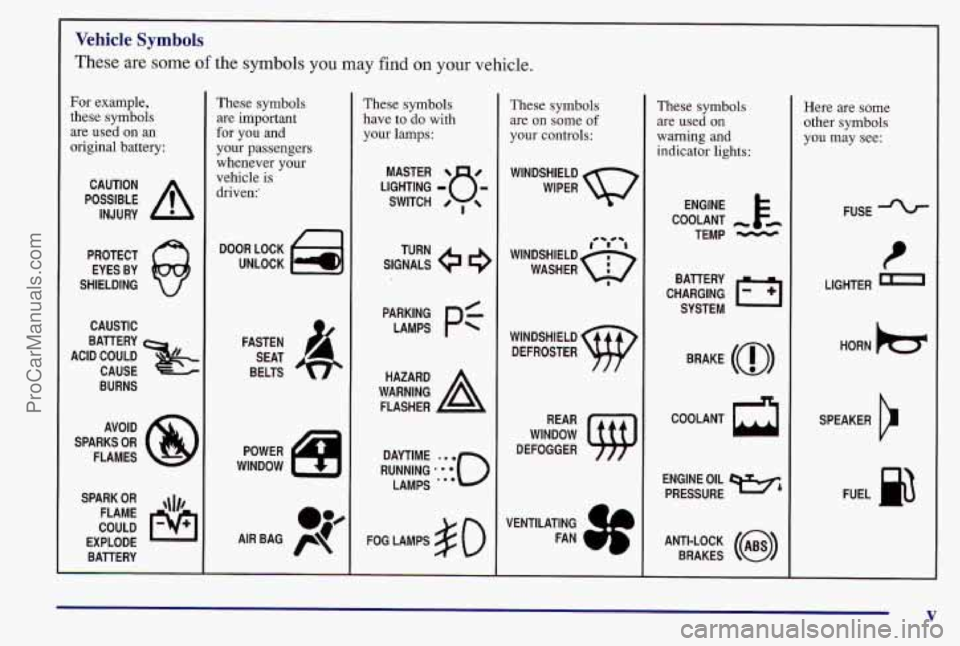
L
Vehicle Symbols
These are some of the symbols you may find on your vehicle.
For example,
these symbols
are used on an
original battery:
POSSIBLE A
CAUTION
INJURY
PROTECT EYES BY
SHIELDING
CAUSTIC
ACID COULD BATTERY
CAUSE
BURNS
AVOID
SPARKS
OR
FLAMES
SPARK
OR ,111,
COULD FLAME
EXPLODE BATTERY
These symbols are important
for you and
your passengers
whenever your
vehicle
is
driven:'
DOOR LOCK
UNLOCK
FASTEN SEAT
BELTS
These symbols
have to
do with
your lamps:
SIGNALS e
TURN
FOG LAMPS # 0
These symbols
are on some
of
your controls:
WINDSHIELD
WIPER
WINDSHIELD DEFROSTER
WINDOW
DEFOGGER
VENTILATING
(
FAN
These symbols
are used on
warning and
indicator lights:
COOLANT -
TEMP -
CHARGING I-1
BAllERY
SYSTEM
BRAKE
(a)
COOLANT
a
ENGINE OIL
PRESSURE
-4
ANTI-LOCK (@)
BRAKES
Here are some
other symbols
you may see:
FUSE
t
LIGHTER a
HORN )tr
SPEAKER
b
FUEL p3
V
ProCarManuals.com
Page 54 of 405
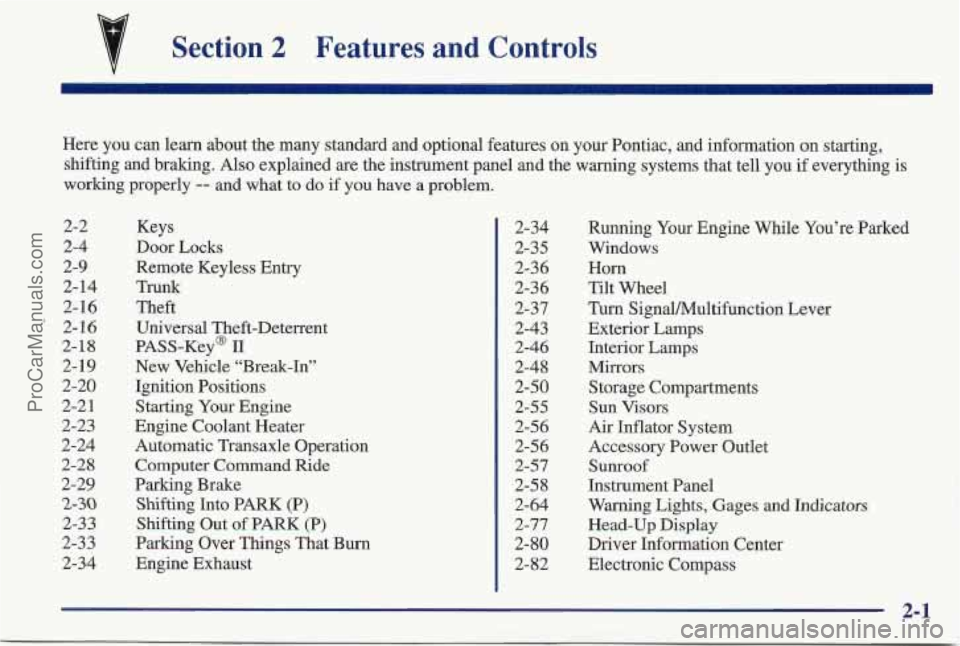
Section 2 Features and Controls
Here you can learn about the many standard and optional features on your Pontiac, and information on starting,
shifting and braking. Also explained are the instrument panel and the warning systems that tell you if everything
is
working properly -- and what to do if you have a problem.
2-2
2-4
2-9
2- 14
2-16
* 2-16
2-18
2-19
2-20
2-2
1
2-23
2-24
2-28
2-29
2-30
2-33
2-33
2-34 Keys
Door Locks
Remote Keyless Entry Trunk
Theft
Universal Theft-Deterrent
PASS-Key@
I1
New Vehicle “Break-In”
Ignition Positions
Starting
Your Engine
Engine Coolant Heater
Automatic Transaxle Operation Computer Command Ride
Parking Brake
Shifting Into PARK (P)
Shifting Out of PARK (P)
Parking Over Things That Bum
Engine Exhaust 2-34
2-3
5
2-3 6
2-36
2-37
1 2-43
~ 2-46
2-48
2-50
2-55
2-56
2-56
2-57
2-5 8
2-64
2-77
2-80
2-82 Running
Your Engine While You’re Parked
Windows
Horn
Tilt Wheel
Turn SignalMultifunction Lever
Exterior Lamps
Interior Lamps
Mirrors
Storage Compartments
Sun Visors
Air Inflator
System
Accessory Power Outlet
Sunroof
Instrument Panel
Warning Lights, Gages
and Indicators
Head-Up Display
Driver Information Center
Electronic Compass
2-.l
ProCarManuals.com
Page 72 of 405
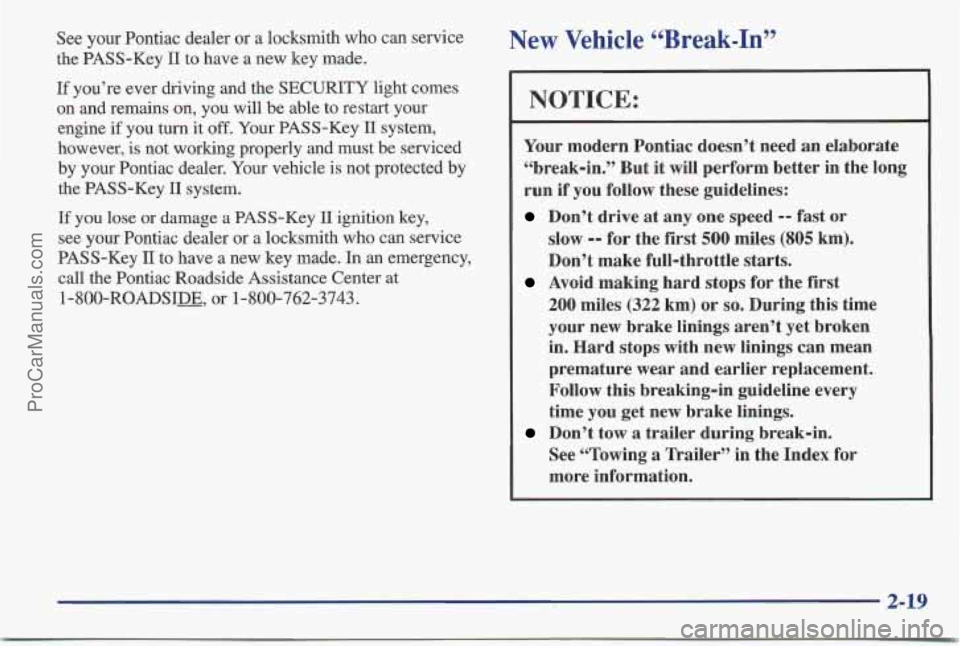
See your Pontiac dealer or a locksmith who can service
the PASS-Key
I1 to have a new key made.
If you’re ever driving and the SECURITY light comes
on and remains on, you will
be able to restart your
engine
if you turn it off. Your PASS-Key I1 system,
however,
is not working properly and must be serviced
by your Pontiac dealer. Your vehicle is not protected by
the PASS-Key
I1 system.
If you lose or damage a PASS-Key I1 ignition key,
see your Pontiac dealer or a locksmith
who can service
PASS-Key
I1 to have a new key made. In an emergency,
call the Pontiac Roadside Assistance Center
at
l-SOO-ROADSI~, or 1-800-762-3743.
New Vehicle CCBreak-In”
NOTICE:
Your modern Pontiac doesn’t need an elaborate
“break-in.” But it will perform better in the long
run if you follow these guidelines:
Don’t drive at any one speed -- fast or
slow
-- for the first 500 miles (805 km).
Don’t make full-throttle starts.
200 miles (322 km) or so. During this time
your new brake linings aren’t yet broken
in. Hard stops with new linings can mean
premature wear and earlier replacement.
Follow
this breaking-in guideline every
time you get new brake linings.
See “Towing
a Trailer” in the Index for
more information.
Avoid making hard stops for the first
Don’t tow a trailer during break-in.
2-19
ProCarManuals.com
Page 78 of 405
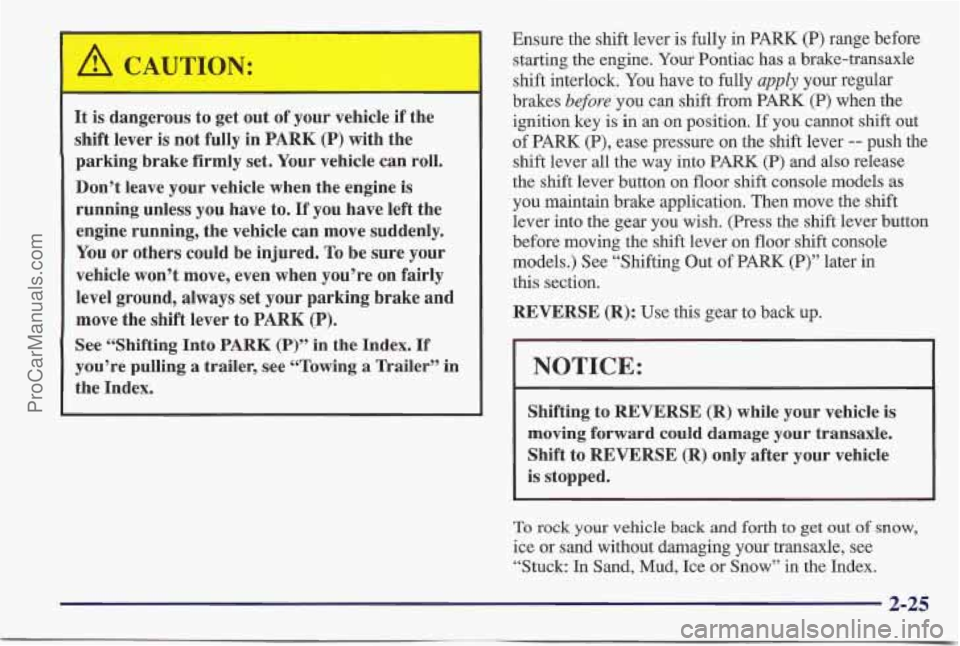
r
It is dangerous to get out of your vehicle if the
shift lever is not fully in
PARK (P) with the
parking brake firmly set. Your vehicle can
roll.
Don’t leave your vehicle when the engine is
running unless you have to. If you have left the
engine running, the vehicle can move suddenly.
You or others could be injured. To be sure your
vehicle won’t move, even when you’re on fairly
level ground, always
set your parking brake and
move the shift lever
to PARK (P).
See “Shifting Into PARK (P)” in the Index. If
you’re pulling a trailer, see “Towing a Trailer” in
the Index. Ensure
the shift lever is fully in PARK
(P) range before
starting the engine. Your Pontiac has a brake-transaxle
shift interlock. You have to fully
apply your regular
brakes
before you can shift from PARK (P) when the
ignition key is in an on position. If you cannot shift out
of PARK (P), ease pressure on the shift lever
-- push the
shift lever all the way into
PARK (P) and also release
the shift lever button
on floor shift console models as
you maintain brake application. Then move the shift lever into the gear you wish. (Press the shift lever button
before moving the shift lever on floor shift console
models.) See “Shifting Out of PARK
(P)” later in
this section.
REVERSE (R): Use this gear to back up.
I NOTICE:
Shifting to REVERSE (R) while your vehicle is
moving forward could damage your transaxle.
Shift to
REVERSE (R) only after your vehicle
is stopped.
To rock your vehicle back and forth to get out’of snow,
ice or sand without damaging your transaxle, see
“Stuck: In
Sand, Mud, Ice or Snow” in the Index.
2-25
- ProCarManuals.com
Page 79 of 405
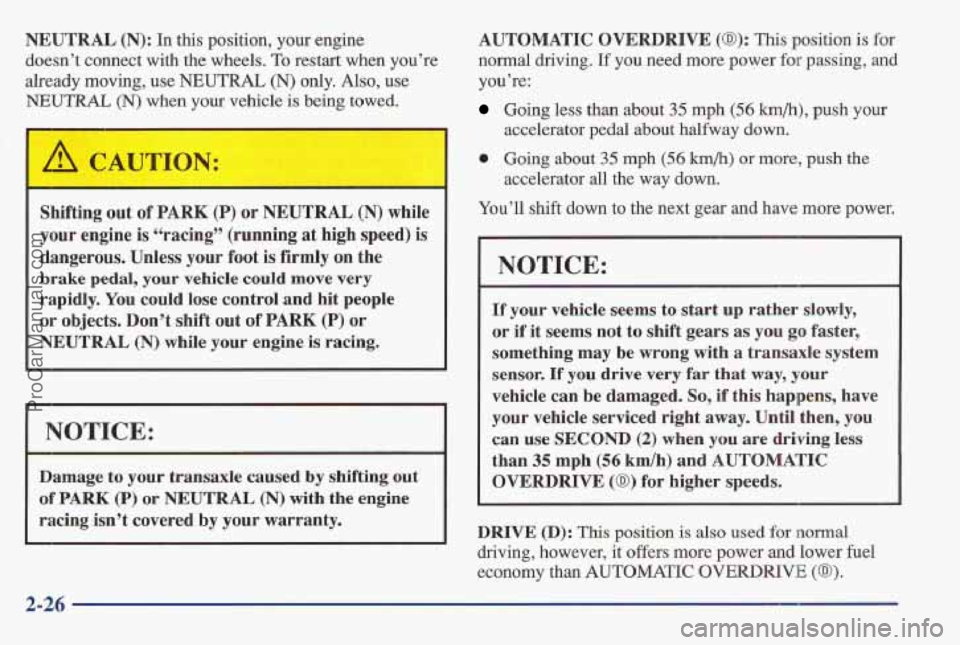
NEUTRAL (N): In this position, your engine
doesn’t connect with the wheels.
To restart when you’re
already moving,
use NEUTRAL (N) only. Also, use
NEUTRAL (N) when your vehicle is being towed.
I
Damage to your transaxle caused by shifting out
of
PARK (P) or NEUTRAL (N) with the engine
racing isn’t covered by your warranty.
Shifting
out of PARK (P) or NEUTRAL (N) while
your engine is
“racing” (running at high speed) is I
dangerous. Unless your foot is firmly on the
brake pedal, your vehicle could move very
rapidly.
You could lose control and hit people
or objects. Don’t shift out
of PARK (P) or
NEUTRAL (N) while your engine is racing.
NOTICE:
AUTOMATIC OVERDRIVE (a): This position is for
normal driving. If you need more power fOr passing, and
you’re:
Going less than about 35 mph (56 km/h), push your
accelerator pedal about halfway down.
0 Going about 35 mph (56 h/h) or more, push the
accelerator all the way down.
You’ll shift down to the next gear and have more power.
NOTICE:
If your vehicle seems to start up rather slowly,
or if it seems not
to shift gears as you go faster,
something may be wrong with
a transaxle system
sensor.
If you drive very far that way, your
vehicle can be damaged.
So, if this happens, have
your vehi’cle serviced right away. Until then, you
can
use SECOND (2) when you are driving less
than
35 mph (56 kmh) and AUTOMATIC
OVERDRIVE (0) for higher speeds.
DRIVE
(D): This position is also used for normal
driving, however, it offers more power and lower fuel
economy than
AUTOMATIC OVERDRIVE (@).
2-26
ProCarManuals.com
Page 80 of 405
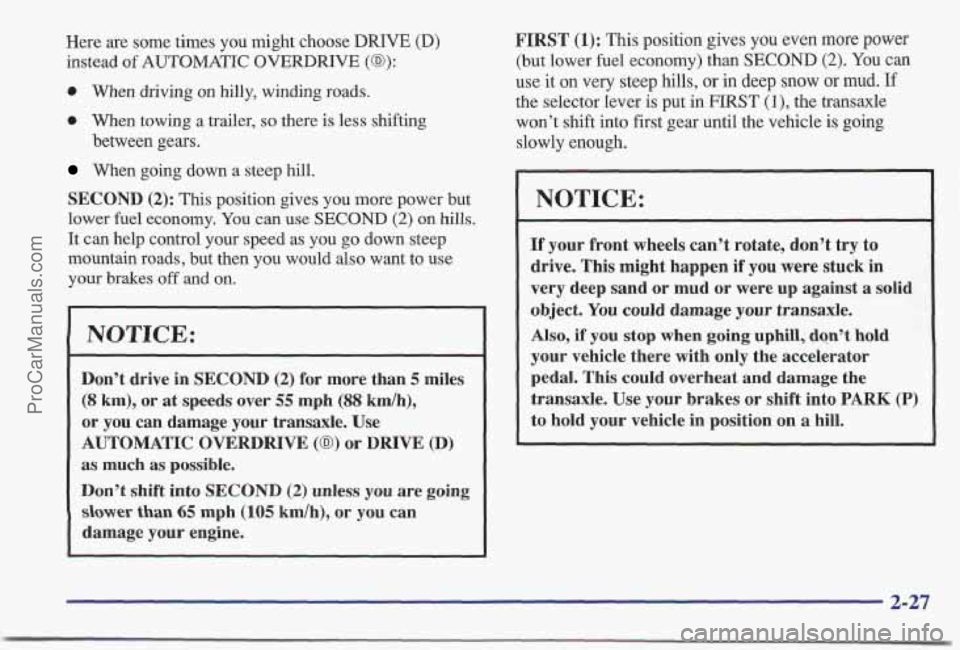
Here are some times you might choose DRIVE (D)
instead of AUTOMATIC OVERDRIVE (@):
0 When driving on hilly, winding roads.
0 When towing a trailer, so there is less shifting
between gears.
When going down a steep hill.
SECOND (2): This position gives you more power but
lower fuel economy. You
can use SECOND (2) on hills.
It can help control your speed as you go down steep
mountain roads, but then you would also want to use
your brakes
off and on.
NOTICE:
Don’t drive in SECOND (2) for more than 5 miles
(8 km), or at speeds over 55 mph (88 km/h),
or you can damage your transaxle. Use
AUTOMATIC OVERDRIVE (@) or DRIVE (D)
as much as possible.
Don’t shift into SECOND
(2) unless you are going
s‘lower than 65 mph (105 km/h), or you can
damage
your engine.
FIRST (1): This position gives you even more power
(but lower fuel economy) than
SECOND (2). You can
use it
on very steep hills, or in deep snow or mud. If
the selector lever is put in FIRST (I ), the transaxle
won’t shift into first gear until the vehicle is going
slowly enough.
I NOTICE:
If your front wheels can’t rotate, don’t try to
drive. This might happen if you were stuck in
very deep sand or mud or were up against
a solid
object.
You could damage your transaxle.
Also, if you stop when going uphill, don’t hold
your vehicle there with only the accelerator
pedal. This could overheat
and damage the
transaxle. Use
your brakes or shift into PARK (P)
to hold your vehicle in position on a hill.
ProCarManuals.com
Page 82 of 405
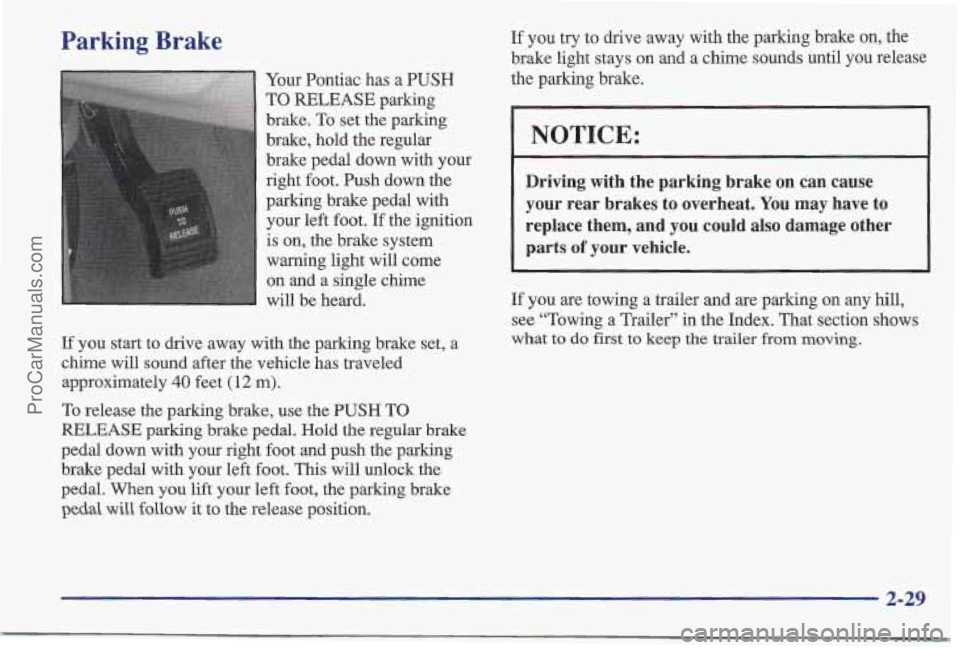
Parking Brake
Your Pontiac has a PUSH
TO RELEASE parking
brake.
To set the parking
brake, hold the regular
brake pedal down with your
right foot. Push down the
parking brake pedal with
your left foot. If the ignition
is on, the brake system
warning light will come
on and a single chime
will be heard.
If you start to drive away with the parking brake set, a
chime will sound after the vehicle has traveled
approximately
40 feet (12 m).
If you try to drive away with the parking brake on, the
brake light stays on and a chime sounds until you release
the parking brake.
NOTICE:
Driving with the parking brake on can cause
your rear brakes to overheat.
You may have to
replace them, and you could also damage other
parts
of your vehicle.
If you are towing a trailer and are parking on any hill,
see “Towing a Trailer” in the Index. That section
shows
what to do first to keep the trailer from moving.
To release the parking brake, use the PUSH TO
RELEASE parking brake pedal. Hold the regular brake
pedal down with your right foot and push the parking
brake pedal with your left foot. This will unlock the
pedal.
When you lift your left foot, the parking brake
pedal will follow it to the release position.
2-29
ProCarManuals.com
Page 83 of 405
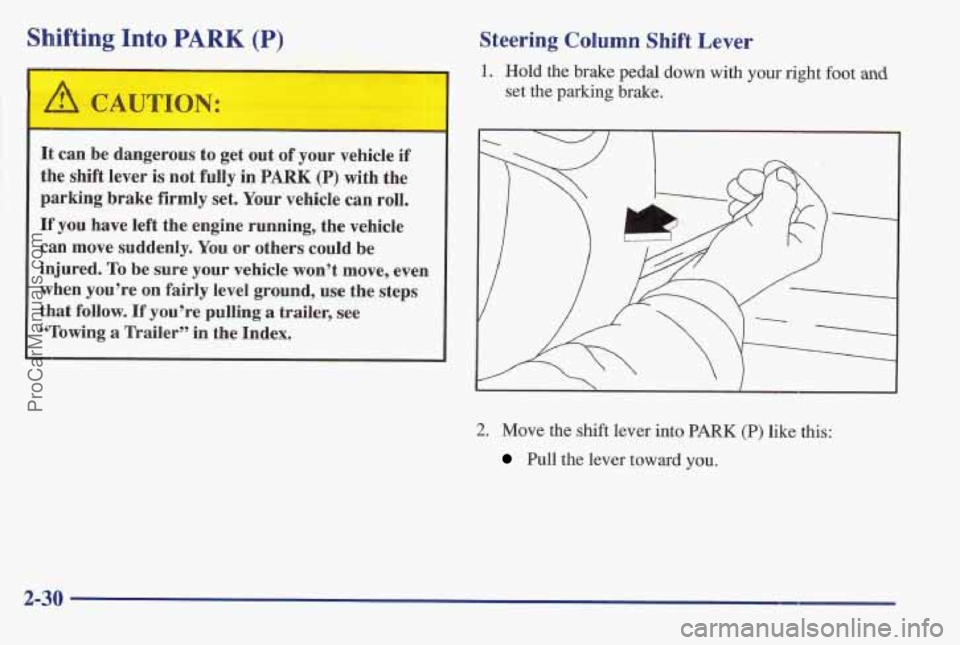
Shifting Into PARK (P)
I-
It can be dangerous to get out of your vehicle if
the shift lever is not fully in PARK (P) with the
parking brake firmly set. Your vehicle can roll.
If you have left the engine running, the vehicle
can move suddenly. You
or others could be
injured.
To be sure your vehicle won’t move, even
when you’re
on fairly level ground, use the steps
that follow.
If you’re pulling a trailer, see
“Tomwing
a Trailer” in the Index.
Steering Column Shift Lever
1. Hold the brake pedal down with your right foot and
set the parking brake.
2. Move the shift lever into PARK (P) like this:
Pull the lever toward you.
2-30
ProCarManuals.com
Page 84 of 405
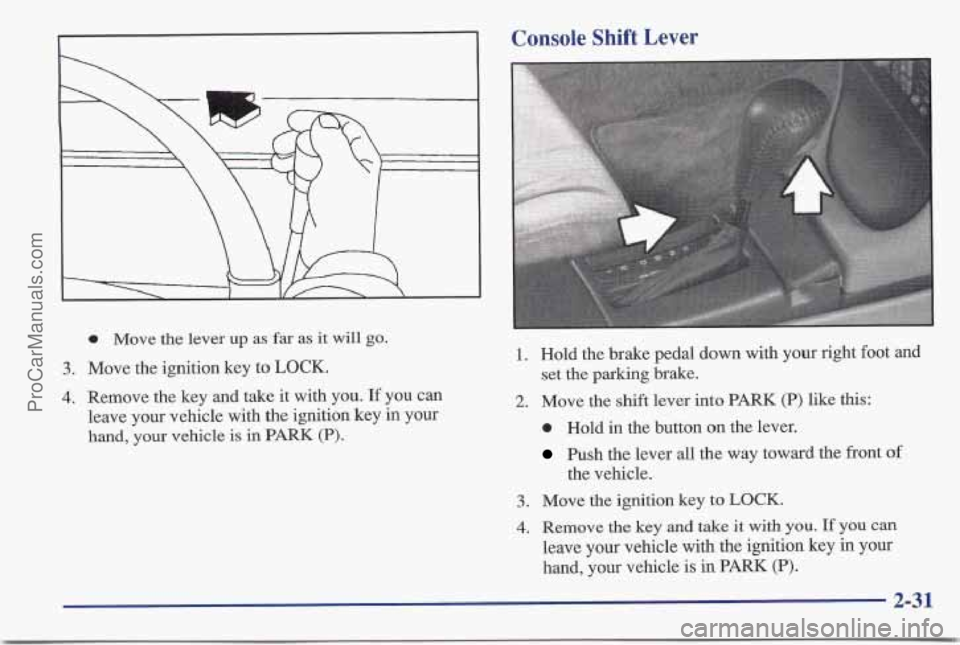
0 Move the lever up as far as it will go.
3. Move the ignition key to LOCK.
4. Remove the key and take it with you. If you can
leave your vehicle with the ignition key in your
hand, your vehicle is in PARK (P).
Console Shift Lever
1. Hold the brake pedal down with your right foot and
2. Move the shift lever into PARK (P) like this:
set the parking brake.
0 Hold in the button on the lever.
Push the lever all the way toward the front of
the vehicle.
3. Move the ignition key to LOCK.
4. Remove the key and take it with you. If you can
leave your vehicle with the ignition key in your
hand, your vehicle
is in PARK (P).
2-31
ProCarManuals.com
Page 85 of 405
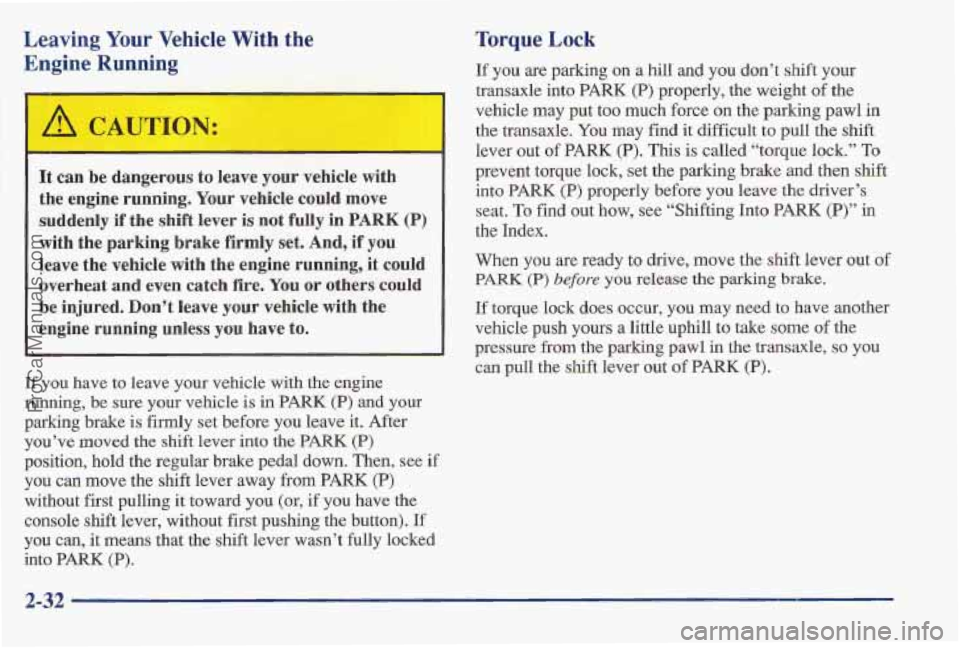
Leaving Your Vehicle With the
Engine Running
It can be ldangerous to leave your vehicle with
the engine running. Your vehicle could
move
sudldenly if the shift lever is not fully in PARK (P)
with the parking brake firmly set, And, if you
leave the vehicle with the engine running, it ,could
overheat and even catch
fire. You or others could
be injured. Don’t leave your vehicle with the
engine running unless you have
to.
If you have to leave your vehicle with the engine
running, be
sure your vehicle is in PARK (P) and your
parking brake is firmly set before you leave it. After
you’ve
moved the shift lever into the PARK (I?)
position, hold the regular brake pedal down. Them, see if
you can move the shift lever away from PARK (P)
without first pulling it toward you (or, if you have the
console shift lever, without fist pushing the button).
If
you can, it means that the shift lever wasn’t fully locked
into PARK (P).
Torque Lock
If you are parking on a hill and you don’t shift your
transaxle into PARK (P) properly, the weight of the
vehicle
may put too much force on the parking pawl in
the transaxle. You may find it difficult to pull the shift
lever out of
PARK (P). This is called “torque lock.” To
prevent torque lock, set the parking brake and then shift
into
PARK (P) properly before you leave the driver’s
seat.
To find out how, se’e “Shifting Into PARK (P)” in
the Index.
When you
are ready to drive, move the shift lever out of
PARK (P) before you release the parking brake.
If torque lock does occur, you may need to have another
vehicle
push yours a little uphill to take some of the
pressure from the paking pawl in the transaxle, so you
can pull the shift lever out of PARK
(P).
ProCarManuals.com